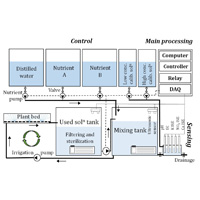Method of pump, pipe, and tank selection for aeroponic nutrient management systems based on crop requirements

Published: 18 June 2020
Abstract Views: 3222
PDF: 1306
HTML: 4905
HTML: 4905
Publisher's note
All claims expressed in this article are solely those of the authors and do not necessarily represent those of their affiliated organizations, or those of the publisher, the editors and the reviewers. Any product that may be evaluated in this article or claim that may be made by its manufacturer is not guaranteed or endorsed by the publisher.
All claims expressed in this article are solely those of the authors and do not necessarily represent those of their affiliated organizations, or those of the publisher, the editors and the reviewers. Any product that may be evaluated in this article or claim that may be made by its manufacturer is not guaranteed or endorsed by the publisher.
Similar Articles
- A. Restuccia, S. Failla, D. Longo, L. Caruso, I. Mallia, G. Schillaci, Assessment of energy return on energy investment (EROEI) of oil bearing crops for renewable fuel production , Journal of Agricultural Engineering: Vol. 44 No. s2 (2013): Proceedings of the 10th Conference of the Italian Society of Agricultural Engineering
- Thanaporn Singhpoo, Khwantri Saengprachatanarug, Seree Wongpichet, Jetsada Posom, Kanda Runapongsa Saikaew, Cassava stalk detection for a cassava harvesting robot based on YOLO v4 and Mask R-CNN , Journal of Agricultural Engineering: Vol. 54 No. 2 (2023)
- Domenico Pessina, Davide Facchinetti, Exposure to vibrations in wine growing , Journal of Agricultural Engineering: Vol. 44 No. s2 (2013): Proceedings of the 10th Conference of the Italian Society of Agricultural Engineering
- Salvatore Faugno, Luisa del Piano, Mariano Crimaldi, Gennaro Ricciardiello, Maura Sannino, Mechanical oil extraction of Nicotiana tabacum L. seeds: analysis of main extraction parameters on oil yield , Journal of Agricultural Engineering: Vol. 47 No. 3 (2016)
- Ioannis Gravalos, Avgoustinos Avgousti, Theodoros Gialamas, Nikolaos Alfieris, Georgios Paschalidis, A robotic irrigation system for urban gardening and agriculture , Journal of Agricultural Engineering: Vol. 50 No. 4 (2019)
- Giorgio Provolo, Aldo Calcante, Francesca Perazzolo, Alberto Finzi, Filippo Volontè, Davide Grimaldi, Mauro Pinnetti, Giorgia Cocolo, Ezio Naldi, Giorgio Galassi, Elisabetta Riva, Environmental assessment of individual and collective manure management systems , Journal of Agricultural Engineering: Vol. 44 No. s2 (2013): Proceedings of the 10th Conference of the Italian Society of Agricultural Engineering
- Hamil Uribe, Rodrigo Figueroa, Luis Llanos, Assessment of linear anionic polyacrylamide application to irrigation canals for seepage control , Journal of Agricultural Engineering: Vol. 44 No. s2 (2013): Proceedings of the 10th Conference of the Italian Society of Agricultural Engineering
- Qing Guo, Huihuang Xia, A review of the discrete element method/modelling in agricultural engineering , Journal of Agricultural Engineering: Vol. 54 No. 4 (2023)
- Daniele de Wrachien, David Proverbs, Report on the 3rd International Conference on Flood Recovery, Innovation and Response (FRIAR) 2012 , Journal of Agricultural Engineering: Vol. 43 No. 3 (2012)
- Lorenzo Picco, Alessia Tonon, Riccardo Rainato, Mario Aristide Lenzi, Bank erosion and large wood recruitment along a gravel bed river , Journal of Agricultural Engineering: Vol. 47 No. 2 (2016)
<< < 10 11 12 13 14 15 16 17 18 19 > >>
You may also start an advanced similarity search for this article.

 https://doi.org/10.4081/jae.2020.1028
https://doi.org/10.4081/jae.2020.1028






